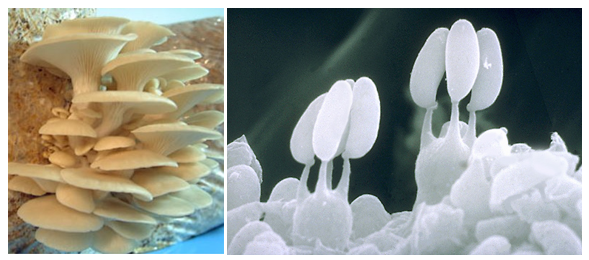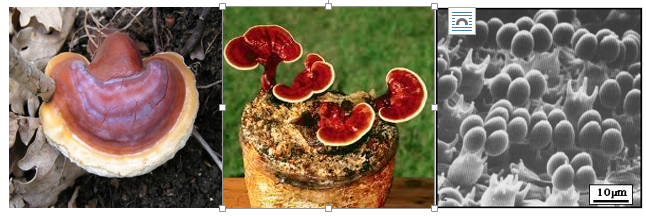Which mushrooms are edible: There are many types of plants, fungi and microorganisms that are beneficial for us. Some of the are edible. However, there are 9 types of mushrooms (fungi) are edible. In this article, we’ll know what mushrooms are safe to eat, how to identify edible mushrooms, pictures of edible mushrooms, edible mushroom species, types of mushrooms.
Which mushrooms are edible
The best 9 types of mushrooms which are edible that are given below-
Order: Agaricales
This is the order that is commonly referred to as mushrooms. Basidiocarps of this order typically are “fleshy” and have a stipe (=stalk), pileus (=cap), and lamellae (=gills) where the basidia and basidiospores are borne (Fig. 5-8). The Basidiospores in this order of fungi are forcibly ejected from the basidium, into the area between the lamellar edges, which then allows the spores to fall free from the mushroom and be dispersed by wind.
The mushrooms in Agaricus are terrestrial saprobes and have caps that are not brightly colored. At maturity, the gills are free or almost free from the stem and are brown to chocolate brown. The stem breaks away cleanly from the cap. Agaricus species have a partial veil which often forms a ring on the stem. The spore print is dark brown.
1.Button mushroom
- Order: Agaricales
- Family: Agaricaceae
- Genus: Agaricus
The common edible cultivated mushroom species is Agaricus bisporus. It is completely white, but in recent years the mushroom industry has developed brown strains of the species. Cap: 3-16 cm, convex to broadly convex or nearly flat in age; dry; smooth or with pressed-down fibers or small scales; white in some varieties, brown in others.

Gills: Free from the stem; close; pinkish to pinkish-brown at first, becoming dark brown to blackish.
Stem: 2-8 cm long; 1-3 cm. thick; sturdy; more or less equal; smooth or with small scales below the ring; white, often bruising brownish; with a ring that sometimes disappears in maturity.


Spore Print: Brown.

2. Field mushroom
Agaricus campestris is commonly known as the field mushroom. It is a widely eaten gilled mushroom closely related to the cultivated button mushroom Agaricus bisporus. It is found in the field of forest areas. The cap is white, may have fine scales, and is 5 to 10 centimeters (2.0 to 3.9 in) in diameter; it is first hemispherical in shape before flattening out with maturity.
The gills are initially pink, then red-brown and finally a dark brown, as is the spore print. The 3 to 10 centimeters (1.2 to 3.9 in) tall stipe is predominantly white and bears a single thin ring. The taste is mild. The white flesh bruises slightly reddish, as opposed to yellow in the inedible (and somewhat toxic)

3. The Horse Mushroom
Agaricus arvensis, commonly known as the horse mushroom, is a mushroom of the genus Agaricus.
The cap is similar to that of Agaricus campestris. The gills are white at first. They later pass through grey and brown to become dull chocolate. There is a large spreading ring, white above but sometimes with yellowish scales underneath. Viewed from below, on a closed-cap specimen, the twin-layered ring has a well-developed ‘cogwheel’ pattern around the stipe. This is the lower part of the double ring. The horse mushroom, Agaricus arvensis Be careful of confusing it with the Yellow Stainer, Agaricus xanthoderma. This one smells strongly of iodoform or ink, not aniseed and its flesh (when cut) stains strongly yellow. The Horse Mushroom will only go yellow on the outside.


4. Shitake mushroom
The shiitake mushroom (Lentinula edodes L-54) is an edible fungus native to Asia, especially in Japan, Korea, and China. It is also considered a medicinal mushroom in some forms of traditional medicine.
The name shiitake originates from its Japanese name, shiitake. Shii is the Japanese name of a tree Castanopsis cuspidata that provides the dead logs on which it is cultivated, and take means “mushroom”.


5. Milky Mushroom (Calocybe indica)
- Family: Lyophyllaceae
- Genus: Calocybe
- Species: Calocybe indica
Milky mushroom (Calocybe indica) is an edible and cultivated fungus in India. The name is derived from the Ancient Greek terms kalos “pretty”, and cubos “head”.
Milky mushroom (Calocybe indica) can be grown on a wide range of substrates as in the case of oyster mushroom. It can be grown on substrates containing lignin, cellulose, and hemicelluloses.
Milky mushroom (Calocybe indica) can be grown on a wide range of substrates as in the case of oyster mushroom. It can be grown on substrates containing lignin, cellulose, and hemicelluloses. Substrate

6. Boletus mushroom
- Family: Bolataceae
- Genus: Boletus
- Species: Boletus edulis, B. badius, B. aereus
The genus Boletus contains many members which are edible and tasty, not the least of which is the famed Boletus edulis, though many others are eaten as well, such as B. badius, B. aereus and others. Many species, such as B. calopus, are bitter tasting and inedible, and others are toxic.
Bolets resemble some gills bearing fungi having fleshy fruiting bodies. Instead of bearing gills on the underside of the pileus, a bolet possess vertically arranged tubes. The pores are visible on the undersurface of the cap e.g. Boletus.


7. Oyster mushroom
- Family: Pleurotaceae – funnel-shaped basidiocarp.
- Genus: Pleurotus
- Species: Pleurotus ostreatus
Pleurotus ostreatus, the oyster mushroom, is a common edible mushroom. It is commercially around the world for food. The oyster mushroom may be considered a medicinal mushroom.
White, cream or brown caps, usually bracket-like with either a radial stem or an eccentric stem; convex gradually becoming centrally depressed with a wavy margin; 5 to 18cm across; often in overlapping groups but with each stem separately attached to the substrate. White, turning pale ochre with age; crowded; decurrent.
- Basidium – Basidia bear four sterigmata each of which bears a spore.
- Spore – Subcylindrical to narrowly kidney-shaped, smooth, 8-9 x 3-4µm.
- Spore print – white to pale lilac-grey.

2. Order: Aphylloporales or Polyporales
Aphylloporales or Polyporales produce single-cell, club-shaped basidia in well-defined hymenium. The hymenium is borne in various ways on definite gymnocarpous sporophores. The hymenium is present on one side of the sporophore (unilateral) or all over the surface ampligenous. The hymenial layer may be smooth, ridged, warted, toothed, porus, or lamellate. If pores or lamellate, the texture or basidiocarp may be papery, leathery, or woody, but not soft or putrescent (decaying) as in mushroom and botes under Agaricales. The basidiocarps may be resupinate, club-like, coral-like, stalked with porous hymenium, stalked with tooth-like hymenium, shelf-like or bracket-like. Some of the Polyporales is commercially cultivated and marketed for use as food items or in traditional Chinese medicine.
In terms of the structure of the hymenophore and the fruiting body, the order is divided into several families: Ganodermataceae, Thelephoraceae, Clavariaceae, Hydnaceae, Polyporaceae, and others.
8. Reishi Mushroom
- Family: Ganodermataceae
- Genus: Ganoderma
- Species: Ganoderma lucidum
Ganoderma is a genus of polypore mushrooms that grow on wood. Because of their extensive use in traditional Asian medicines, and their potential in bioremediation, they are a very important genus economically. Ganoderma can be differentiated from other polypores because they have a double-walled basidiospore.
Ganoderma is characterized by basidiocarps that are large, perennial, woody brackets also called “conks“. They are lignicolous and leathery either with or without a stem. The fruit bodies typically grow in a fan-like or hoof-like form on the trunks of living or dead trees. They have double-walled, truncate spores with yellow to brown ornamented inner layers. They are popularly referred to as shelf mushrooms or bracket fungi. The popular edible mushroom Ganoderma lucidum (Reishi) is widely used for the general promotion of health and longevity in Asian countries. The dried powder of G. lucidum is popular as a cancer chemotherapy agent in ancient China.

9. Jelly Fungi
In jelly fungi, the basidiocarp becomes shrunken and shriveled, when dried, but with available moisture revives to its original consistency. This type of basidiocarp is said to be gelatinous. There are several orders in this group of fungi and they are delimited by the morphology of their basidium. The basidia are typically septate, the exception being the tunning fork basidium, which is aseptate, but is deeply lobed and produces only two basidiospores. Three orders will be described below: The Tremellales, Auriculariales, and Dacrymycetales.
9. Jelley mushroom
- Order Tremellales
- Family Tremellaceae
- Genus: Tremella.
- Species: Tremella aurantia
The basidia are longitudinally divided. Most species are saprophytic on wood or are associated with other wood-rotting fungi. They form fruiting bodies that are gelatinous and often brightly colored when wet, drying to a cartilaginous texture.
Tremella aurantia (Common Name: Witch’s Butter) is an edible fungus.
Sporocarp – Fruit bodies 2-10 cm broad, consisting of clustered, convoluted folds with blunt margins; surface yellow, to yellowish-orange, shiny when wet, otherwise dull; context gelatinous, drying to a stiff, hard crust, reviving after periods of moisture; odor and taste not distinctive.
Spores – Spores 6.0-9.5 x 6.0-7.5 µm, subglobose to ovoid, smooth, thin-walled with a conspicuous hilar appendage; basidia longitudinally septate, typically stalked, 10-14 µm broad.

Order: Auriculariales
- Family: Auriculariaceae
- Genus: Auricularia
- Species: A. auricular polytricha
As is the case of the Tremellales, many species have a gelatinous basidiocarp, reminiscent of the consistency of jelly. This order is characterized by having a transversely septate basidium. Auriculariaceae – the presence of a tuning fork basidium. The basidiocarps are typically some shade of yellow-orange and Auricularia auricula grows throughout the country with a rubbery texture. A type of jelly fungus, it produces fruit bodies that are translucent, brown in color and ‘ear’ shaped, hence its Chinese name ‘Wood Ear’. Both A. auricula and A. polytricha are considered as Chinese medicine and today are used interchangeably.
